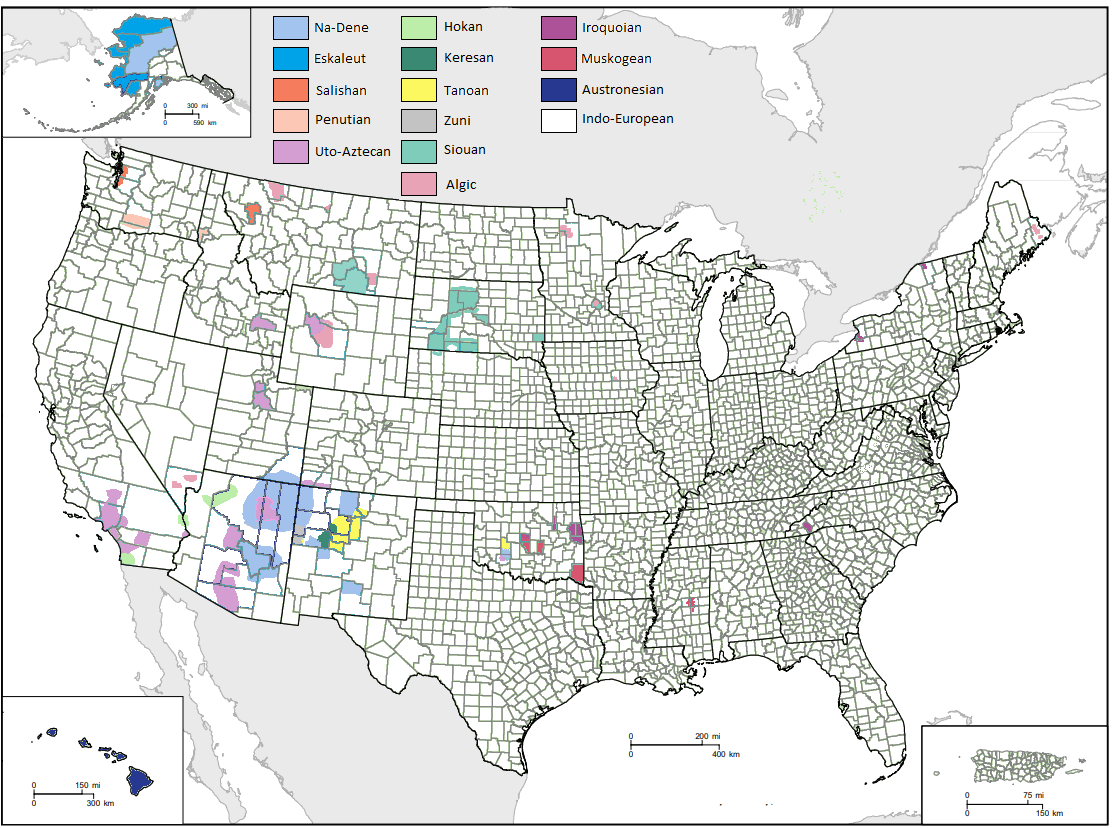Indigenous Languages Families Distribution in the U.S. Map


Marcus Rodriguez
Historical Geography Expert
Marcus Rodriguez specializes in historical cartography and geographic data analysis. With a background in both history and geography, he brings unique...
Geographic Analysis
What This Map Shows
The "Indigenous Languages Families Distribution in the U.S. Map" visually represents the geographic distribution of various indigenous language families across the United States. Each color on the map corresponds to a specific linguistic family, highlighting the rich tapestry of Native American languages that have persisted through centuries. It serves as a reminder of the diverse cultural heritage that exists within the U.S., as these languages are not just modes of communication but are also deeply intertwined with the identities and histories of the indigenous peoples.
Deep Dive into Indigenous Languages
Indigenous languages in the United States encompass a wide array of languages that belong to several distinct language families. Some of the most prominent families include Algic, Siouan, Iroquoian, and Uto-Aztecan. Each of these families contains multiple languages, many of which are still spoken today, while others have unfortunately become extinct.
Interestingly, the number of languages within these families varies significantly. For instance, the Algic family includes languages such as Ojibwe and Cree, which are still spoken by many communities across the Midwest and Canada. In contrast, the Iroquoian family, which includes languages like Mohawk and Cherokee, has seen varying degrees of revitalization efforts. Cherokee, for instance, is experiencing a resurgence due to educational programs aimed at younger generations.
What's fascinating is how indigenous languages often reflect the unique ecological and cultural contexts of their speakers. For example, many Native American languages have intricate vocabulary and terms describing local flora and fauna, which can offer insights into the environmental knowledge and practices of indigenous communities. This linguistic connection to the environment underscores the importance of language preservation, not only for cultural identity but also for maintaining traditional ecological knowledge.
According to the Endangered Languages Project, many indigenous languages are classified as endangered, with some having fewer than 10 speakers left. This alarming trend poses a significant threat to the cultural diversity of the U.S., as each language lost represents a unique worldview and way of life. Language revitalization efforts are crucial, and various tribes are actively working to teach their languages in schools and community programs to ensure that future generations can learn and embrace their linguistic heritage.
Regional Analysis
The map reveals distinct regional patterns in the distribution of indigenous language families. In the Northwest, for example, the Salishan language family is prominent, with languages like Salish and Lushootseed spoken by various tribes. This area is characterized by a rich cultural history and deep connections to the region's waterways and forests, which are reflected in the language itself.
Moving to the Southwest, the Uto-Aztecan family dominates, with languages such as Nahuatl and Hopi. This region showcases a blend of linguistic and cultural influences, as many Uto-Aztecan speakers have historical ties to ancient civilizations, including the Aztecs. The distinct languages in this region often include terms related to agriculture, desert life, and traditional practices, demonstrating how the environment shapes language.
In contrast, the Great Plains are home to several languages from the Siouan family, such as Lakota and Dakota. These languages encapsulate the nomadic lifestyle of the Plains tribes, with vocabulary that reflects their close relationship with the land and its resources. This connection is vital for understanding their cultural practices and social structures.
Significance and Impact
Understanding the distribution of indigenous languages is essential for recognizing the cultural and historical significance of Native American tribes in the U.S. It highlights the need for language preservation efforts, as these languages are repositories of rich cultural knowledge and traditions. The decline of these languages can lead to the erosion of cultural identity and traditional practices, which are often passed down through language.
Moreover, the revitalization of indigenous languages has real-world implications, not just for the communities involved but for society as a whole. Multilingualism can foster greater cultural appreciation and understanding, which is crucial in today’s increasingly connected world. Educational initiatives that include indigenous languages can promote inclusivity and empower native speakers, allowing them to share their unique perspectives and experiences.
As we move forward, it's vital to support efforts aimed at preserving and revitalizing these languages. This includes funding for language programs, teaching resources, and community engagement initiatives. By doing so, we help ensure that these languages and the cultures they represent continue to thrive and enrich the fabric of American society.
Visualization Details
- Published
- October 13, 2025
- Views
- 58
Comments
Loading comments...